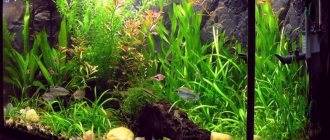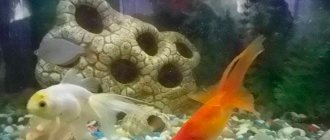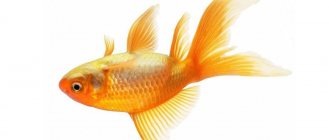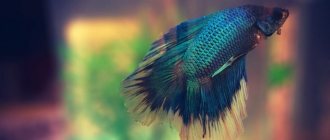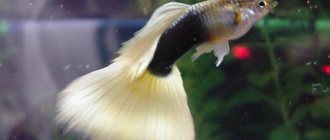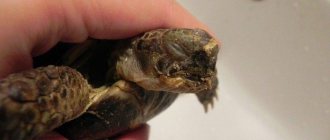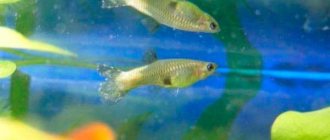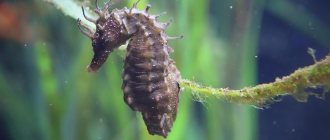Why do pets swim belly up?
There are several reasons for this phenomenon:
- infections;
- parasites;
- fungi;
- hunger;
- bladder (swimming) disease;
- fin pathology;
- gas formation.
The most dangerous of these causes is inflammation of the bladder, as it is infectious. Occurs due to poor food or improper care. The disease can occur in an acute form, when the pet dies within a week: first it stops eating, then it swims on its side or head down, the spine begins to bend, ulcers form on the bladder, and the fish dies. The second option is a chronic form, the disease lasts up to a month: first, the pet begins to eat little, the bladder becomes inflamed and begins to gradually change shape, the fish does not have enough oxygen, and it dies.
If you notice the disease in time and take action, the fish can be saved. The main thing is not to feed them during the treatment period.
Other fish diseases
Trichodinosis - an infected guppy does not show external signs of the disease. Gradually a white coating appears, which falls off in flakes. Mucus appears on the gills, the fish does not eat, and begins to breathe more often. If there are no residents in the container, the parasitic ciliates will die on their own within a few days.
Costiosis (ichthyobodosis) - a mucous coating appears on the guppies, the fish moves little, refuses to eat, bluish spots turn into a white coating. The gills become covered with mucus, breathing becomes difficult, and the fins begin to stick together. If a disease is detected, it is recommended to quarantine the pet and keep it in water at a temperature of 25 degrees for several days.
Guppies are dying in the aquarium - what to do
Message body: Hello! Help, please, I don’t know what to do anymore... Aquarium 150 liters. (this is minus the soil, decorations, etc.) They live: guppies - 5 adults, other fry, 5 neons, 2 danios, 2 catfish - speckled and golden, 2 huge ancitrus and fry (they breed like rabbits for me , every month 30-50 pieces). Filter for 150-250 liters, heater, bottom siphon, water change once a week.
About 1.5-2 weeks ago I saw fin rot in the guppy. I treated it with ANTIPAR for about a week. The water became completely bad, I began to notice that the guppies were dying, no longer “gnawed” by this rottenness, but completely healthy in appearance, and the rest of the fish felt bad in this water, I decided to replace all the water, and if the guppies were not cured, then in a small amount in the aquarium to finish treating them. I planted them in 2 aquariums of 30 liters each. every. Ancitrus in one, all others in another. While I was washing the large aquarium for 2 days, the ancitrus in the small one began to die. Well, apparently there wasn’t much room for them at all; they were hanging on the wall opposite the filter, at the water’s edge. Quickly, I filled a large aquarium with water, added AGUASAFE according to the instructions, let it sit for another day with the filter on, and put them all in there. The next day, I just raked out a bunch of dead ancitrus... And they also continue to hang on opposite the filter at the water’s edge. I replaced some of the water, removed the excess food, but they still died. I decided that they didn’t have enough air. I read that it is impossible to oversaturate water with oxygen, so I hung up 2 more filters from small aquariums, 50 liters. each is calculated. They still hang at the edge. Well, the guppies are behaving somewhat restlessly. Sometimes they lie on the day, sometimes they rush about in a stream of bubbles. Neons and danios seem to behave normally, adult ancitruses too, the male hatches the eggs again, and the female either crawls out or climbs back into the house. There doesn’t seem to be any plaque on the fish, nor mucus. anything new to the aquarium , only the filter was slightly cracked and I covered it up a little with plasticine, well, I’ve already picked it back, thought about it, maybe it will release something and they will be poisoned. Yesterday evening we ate everything normally, both ancitrus and other fish. And now exactly what happened to them...the heart bleeds to pull out small corpses...
Description and origin
The guppies living in the aquarium are descendants of wild representatives of this breed, imported from freshwater bodies of water located in the southern Caribbean, Venezuela and Brazil. Fish prefer crystal clear water and will never be able to live in salty sea water .
Guppies come from the coast of South America.
Guppies were specially brought and acclimatized to the tropics, where many malarial mosquitoes live, since insects are part of their diet.
The aquarium species are peaceful vertebrates that coexist well with other non-aggressive fish species. They feel good even not in large aquariums.
Males and females can be easily distinguished by external characteristics: body shape, color and size. The male is about 4 cm long. Selected species have long, beautiful fins of various colors. The body is slender and slightly elongated. The female is much larger, its length reaches 6 cm, it has rounded shapes and a nondescript body color with a clearly defined mesh of scales.
Why does a white coating appear on fish and how to treat it
Diseases: saprolegniosis and gyrodactylosis
Dermatomycosis, or saprolegniosis, is a fish disease that appears as a result of prolonged exposure to cold water. Other associated factors, such as improper feeding, injury, stress, high acidity levels, increased concentration of organic matter in water can cause fungi of the genus Saprolegnia and Achlia. Other infectious diseases often appear as concomitants with saprolegniosis. The disease spreads quickly throughout the aquarium, passing from sick fish to healthy ones.
The initial stage of the disease - a coating in the form of moss forms on the fish, as well as white threads, the so-called “fungal hyphae”. Hyphae may appear when an injury, cut, or ulcer is localized. When they grow, they intertwine with each other and form a lump resembling white cotton wool. Lumps are distributed throughout the body, also on the fins. Later, the internal organs of the fish become sick.
See how to treat dermatomycosis and other diseases of aquarium fish.
The fish should be treated in a fish tank. To destroy the fungus, the drug bicillin-5 is used. A dose of the drug is added to the aquarium: 500,000 units per 100 liters of water. Before adding to water, the medicine should be diluted in water. The duration of treatment with bicillin-5 is 6 days. During treatment, the temperature is increased to 25-26°C. Please note that not all aquarium fish can tolerate the given temperature. It is necessary to remove plants and decorations from the general aquarium and treat them with the same preparation. The drug only works in the dark.
Gyrodactylosis is a disease in which a bluish-white coating forms on fish. The fins are compressed, the sick fish rubs against the scenery, becomes lethargic, and its eyes become cloudy. The pet also stays near the surface of the water and moves in oscillations. Later, the rays of the fins are destroyed, and ulcers are visible on the body. Fish affected by the disease may die from lack of air or exhaustion. The causative agent is a parasite of the genus Gyrodactylus. Its dimensions are miniature – up to 0.8 mm in length; it is attached to the host’s body using hooks. The parasite is very dangerous for fish fry.
Treatment is possible in the prison. You need to add 15 mg of copper sulfate per 10 liters of water to the water. In the main aquarium, parasites will die without fish within a week, so disinfection is not necessary. To prevent the fry from becoming infected with the infestation, the spawning aquarium must be treated with table salt for 24 hours.
Trichodinosis and costiosis
Trichodinosis is an invasive disease caused by ciliates. At an early stage, there are no obvious changes in the pet’s appearance. Only she itches on stones and decorations, and is often located near aeration bubbles. As the disease develops, the body becomes covered with a white coating; over time, it will begin to fall off in flakes. The gills are covered with mucus, the fish has no appetite, and breathing is rapid. Infection can be introduced into an aquarium through dirty water, decorations, plants, food, soil, and sick fish. If there are no fish in the general aquarium, the ciliates without a host will die in a few days.
See what a mollies infected with trichodinosis looks like.
Treatment takes place in a quarantine tank, where the water temperature is raised to 30 degrees Celsius. You need to turn on strong aeration. You need to add table salt to the water in proportions of 20 grams per 10 liters of water. In the initial stages, the disease can be treated.
Ichthyobodosis, or costiasis, is a parasitic disease caused by the flagellate Costia necatris. At first, the sick fish is inactive, refuses food, and rubs against the aquarium decor. When the parasite multiplies, irritation and mucus appear on the skin. Later, gray-blue spots will appear on the fish, developing into a white coating. The gills become enveloped in mucus, making it difficult for the fish to breathe - it rises to the surface of the water, taking in air. The fins stick together.
The parasite can get into the water with soil, food and sick fish. If there is a host, the flagellate actively reproduces. The disease is carried by fish and fry, which receive a variety of foods. The disease is treated with malachite green or methylene blue. If you raise the temperature in a common aquarium with fish to 34 degrees, the parasites will die. Fish can also be treated in baths. Dilute 0.1 grams of potassium permanganate in 10 liters of water and keep the fish in the solution for 40 minutes. Another recipe for a medicinal bath: dilute 150-200 grams of table salt in 10 liters of water, and keep the fish in the solution for 10-15 minutes. It is advisable, after the onset of the disease, to transfer the pets to a quarantine tank and maintain the temperature in it at 25 degrees during the treatment period.
>
Diseases
The list of diseases of aquarium fish is huge; experienced aquarists and people with special education understand them. If you lack experience, it is better to consult a doctor.
Fin rot
The disease appears in dirty water when the fins are injured. If you ignore the disease, after the destruction of the fins, damage to the body will begin and the fish will die. Fin rot is treated:
There are many methods for treating fin rot. The treatment is discussed in detail in a separate article.
Plistophorosis
The disease is also called “neon disease” and pleistophorosis. The fish's muscles are affected and ulcers appear on the body. Plistophorosis cannot be treated; the diseased individual must be destroyed. Boil the soil and decor, rinse the aquarium.
Red scab
The disease most often affects males. Remove the parasite-affected areas of the fins with a blade. Place the guppies in salted water (1 g salt per 1 liter). Treat in combination with levomycin (1 tablet per 30 l) or furazolidone (0.5 tablets per 10 l). The course of treatment is 5 days. Remedies for ichthyophthyriosis also help. The tail grows back after some time.
Scoliosis
If the spine is curved, and no other symptoms of disease are observed, then the curvature may be congenital. Individuals with scoliosis can lead normal lives, but they are smaller and weaker than healthy guppies. Scoliosis that appears in an adult fish can be corrected by reducing portions during feeding and introducing variety into the diet. During pregnancy, the female monitors the aeration in the aquarium and does not allow inbreeding.
Tetrachymenosis
The ciliates Tetrahymena infect the gills and fins. Place the sick fish in salted water (1 g of salt per 1 liter) with increased aeration. Add a solution of biseptol (1 tablet per 50 liters of water) or furazolidone (0.5 tablets per 10 liters) into the water. Prevent healthy fish by mixing a small amount of furazolidone with food.
Tuberculosis or mycobacteriosis
In addition to weight loss and curvature of the spine, there is a fading of color. Treatment is possible in the early stages; a number of aquarists consider the disease incurable. Place the fish and add kanamycin (30–50 mg per liter) to the water daily for 10–14 days with daily water changes. You can soak the food in a solution of kanamycin (0.5 g of the drug per 100 ml of water). Another method: adding isoniazid (1 tablet per 60 l) for 3 days. Then a break is taken for 2 days. The course is repeated 2-3 times. After transplanting the sick fish, disinfect the aquarium, wash the decorations and boil the soil.
Dropsy ascites
In addition to the abdomen, fish have enlarged eyes. Guppy tends to hide and spend more time at the bottom. Dropsy appears for various reasons:
Treat dropsy with frequent changes and adding salt to the water (1 tablespoon of salt per 10 liters). Put your guppy on a hunger strike for a couple of days and review its diet. Increase aeration and add antibacterial drugs, for example, chloramphenicol (mix 250 mg of the drug with 25 g of feed or 10 mg per 1 liter of water).
Trichodinosis
The parasitic disease is most dangerous for fry. Damage to ciliates begins with the fins, and in the last stages the gills are affected. Raise the temperature and increase aeration. For every 10 liters of water add 1 tbsp. l. salt. Use malachite green or methylene blue in proportions of 5 ml per 10 liters of water.
Columnaria
Advanced disease is accompanied by ulcers. You can cure it with bicillin-5 (one-third of a bottle per 100 liters of water, shade the aquarium during exposure) and methylene blue (5 ml per 10 liters of water).
Ichthyophthiriasis (semolina)
Carry out treatment in salted water (1 teaspoon per liter of water) with an increase in temperature by 2-3 degrees. Use biomycin and trypaflavin, course of treatment for 2 weeks. You can read more about the disease ichthyophthyriosis in another article.
Oodiniumosis
“Velvet rust” is treated with copper sulfate (0.2 mg per 1 liter of water) with an increase in temperature. If oodiniumosis is not completely eliminated, repeat treatment after 2–3 days.
Costiosis
In addition to plaque and inhibited behavior, the disease is characterized by protruding, pale gills. In the early stages, treat costosis with malachite greens in accordance with the instructions. Salt baths with potassium permanganate (1 teaspoon of salt per 1 liter of water, potassium permanganate until slightly pink) for 10–15 minutes are effective.
Hexamitosis
Spironculosis, octomitosis or hole disease is a rare disease for guppies. It is treated with metronidazole (250 mg per 35 liters of water) with water changes.
Hermaphroditism
It cannot be treated and is not noticeable externally. Self-fertilization rarely occurs in females, and the offspring are infertile.
Why do fish start to die?
Newbie mistakes lead to the death of fish. The most common ones are listed below.
Water pollution
Guppies die from contamination in the aquarium, which causes disease, poisoning and lack of oxygen. The liquid must be free of impurities and dechlorinated.
Nitrogen poisoning
When poisoned by nitrogen compounds, the fish's eyes bulge and it shows signs of oxygen starvation. Increase aeration and replace up to 40% of the liquid. Find out how much the concentration of nitrogen compounds in the water is and neutralize the excess using conditioners.
Water temperature
If guppies are kept at inappropriate temperatures (22-28 degrees), they are susceptible to disease. A sudden change in temperature leads to temperature shock and death.
Incorrect launch of fish
Neglecting quarantine when introducing a new fish can lead to the fish dying one by one. The new fish should be observed in a separate container for at least 3-4 weeks, and only if there are no diseases can it be placed in a common aquarium. It is also necessary to gradually adapt newly acquired fish to the conditions of a particular aquarium. Do not release the fish from the bag into the aquarium immediately; add new water little by little every 15–20 minutes.
Fish diseases
Diseases are a common cause of death. Observe the behavior and appearance of the fish, do not delay treatment if you suspect a disease.
Water quality
The quality of the water environment is declining due to:
- Irregular or incomplete aquarium maintenance. Proper care involves siphoning the soil, replacing 25% of the total volume of liquid with clean liquid, and washing the decorations and filter components.
- Overfeeding Excess feed falls to the bottom, polluting the water. Feed your pets small portions and fast them once a week.
- Overpopulation. In a densely populated aquarium, the liquid becomes contaminated faster.
- Lack of equipment. The liquid needs constant filtration and aeration. An aquarium without equipment requires frequent water changes.
Aggressive neighbors
Harassment from neighbors is another cause of death for guppies. Incorrect compatibility leads to injury and severe stress. Aggressive neighbors can chase the fish to death and even eat it.
Acclimatization
Not all guppies can survive adaptation to new conditions and transportation. Old and weak fish often die, even if the aquarist has caused little concern to the pets.
Common reasons why fish may die
What to do if guppies die - check the quality of the water in the aquarium. After all, the main reason is poor conditions for keeping fish, namely dirty water that does not meet standards.
Recommended content parameters:
To improve the quality of water, you can use various additives, which are abundant in pet stores.
- Temperature – 22-26°C, but for non-selection species this range can be expanded – 19-29°C;
- pH – from 6.5 to 7.5, this indicator can be measured using a drop test;
- Oxidability – 2-6 mg O₂/l; these parameters can be used to judge the amount of organic substances, for example, excrement or food that was not eaten;
- Carbonate hardness – 8.0-15.0 mg-eq/l;
- Nitrite concentration - this indicator should not exceed 80-100 mg/l.
Also for newly launched aquariums it is worth monitoring the ammonia concentration. Since fish produce ammonia during their life, its high content can lead to undesirable consequences.
Of course, guppies can die for natural reasons - from old age, but high-quality and timely care can significantly extend their life. By the way, the life expectancy of these fish is relatively short and is 3-4 years.
In order for the water to always remain clean, it is necessary to change 20% of the total volume of water to fresh weekly , and then the fish will not have to breathe in the waste of their vital activity.
Why do guppy fish turn over on their side?
Any inappropriate behavior of animals is the result of pathology. If a guppy is swimming on its side, it means it is seriously ill. This is how the dangerous disease glugeatosis manifests itself. Also with this disease, bulging eyes appear, usually only on one side.
The cause of gluteatosis is sporozoans. These are intracellular parasites that eat internal organs. The disease is incurable, so at the first sign you need to immediately destroy the contents of the aquarium and disinfect the container.
Tips for fish lovers
The development of many diseases can be avoided if you purchase fish and aquarium components from reliable pet stores. In order to prevent the penetration of parasites into the home pond, new fish should be kept in quarantine for some time. At the same time, you must remember to allocate separate nets and equipment for them.
Under properly organized conditions, guppies rarely get sick. Improved care and compliance with the basic rules for maintaining aquarium inhabitants will be the best prevention of all diseases.
Guppy swims belly up
There are many reasons why a fish can swim belly up, here are some of them:
- Viral or bacterial infections;
- Infestation with parasites;
- Cancer or fungal diseases;
- General weakness;
- Starvation;
- Fin or swim bladder disease;
- Increased gas formation in the gastrointestinal tract.
But the main reason should be considered inflammation of the bladder - this is a contagious disease that is caused by infection. The disease was first identified in the 50s. Infection occurs due to poor quality food and improper aquarium conditions.
Forms of the disease:
- Acute – occurs in severe form, lasts 6-7 days. The guppy stops eating, falls over on its side or upside down, and begins to float belly up. The internal organs begin to become inflamed, and curvature of the spine occurs. The bladder becomes covered with purulent ulcers, which gradually penetrate inside. The fish lose a lot of weight and die.
- Chronic – is not so acute, lasting about a month. Guppy eats, but very little. Inflammation of the organs and bladder becomes purulent. The bubble gradually changes its shape and due to lack of oxygen, the fish swims close to the surface with its belly up.
If you start treating your fish as soon as the first symptoms appear, the prognosis may be favorable. During the treatment period, guppies must be left without food, this will help stop the inflammation process.
The fish swims strangely
Read also: What Happens If You Pour Salt into the Wound
It is very important to know what behavior is typical for a given species. For example, nocturnal fish may look lethargic during the day and vice versa. Some fish species rarely show activity at all! Fish recently introduced into an aquarium are usually inactive for some time as a result of shock and stress. If such a fish is left alone, it quickly begins to come to its senses. Fish may become less active as they age.
However, if any fish become less active compared to their normal behavior, this is most likely an early but non-specific sign of illness. Certain fish behaviors are usually signs of disease. It should not run around like crazy or stand in one place, should not hide, hang in a corner or lie on the bottom. It is not normal for a fish to make movements such as coughing, choking or yawning; itches; vibrates; loses control over the coordination of movements, somersaults, floats up or drowns. If several fish behave abnormally, this is a clear alarm signal. The fish may swim upside down or upside down, stand in the corner of the tank, or hide in an attempt to avoid aggression from other fish. Lethargy usually increases as the disease progresses and decreases as the fish recovers.
Breeding problems
Guppies easily breed in an aquarium, but in some cases, owners note problems in breeding fish. Main reasons:
- Hermatophrodism - it is difficult to detect the disease during visual examination, since female guppies have male genital organs at the same time as female ones. The causes and treatments are not yet clear.
- Infertility is a disease when females are unable to give birth. The color of the guppies loses its saturation, the fish become faded. The causes of the disease are very powerful, bright or prolonged lighting. This disease has no cure.
Problems of juvenile development
The first symptoms that indicate poor health in guppy fry are lethargic behavior and loss of appetite. The fry are always at the bottom of the aquarium or swim near the surface of the aquarium. Problems arise due to poor water quality, irregular cleaning and significant reservoir population.
Stages of growth of guppy fry from birth to adulthood.
The birth of fry with a deformed body or underdeveloped fish with yolk sacs is a sign of improper keeping of the female in the aquarium.
Timely diagnosis of the disease and its correct treatment is an important stage. Sick guppy fry need to be transplanted and the nursery should be disinfected. This will save the rest of the brood from death.
Plistophorosis in guppies
There are many diseases that can affect this breed. Plystophorosis is considered one of the most dangerous. The disease appears suddenly and inevitably leads to death.
Often with this disease, the guppy swims with its tail down. Other signs of infection may include:
- spasmodic method of movement of fish;
- attempts to take a vertical position;
- loss of appetite and exhaustion;
- faded body color;
If guppies begin to swim upside down, it can be assumed with a high degree of probability that they are developing this particular disease.
Plistophorosis is quite rare. Healthy individuals become infected with it as a result of ingesting parasite spores. Water, soil or aquatic vegetation from an infected reservoir contain them in huge quantities. Poorly treated fishing equipment and equipment are also dangerous. The causative agent of the disease is able to penetrate the female’s ovaries and eggs. Thus, the disease has a hereditary transmission mechanism.
Unfortunately, there is still no treatment available. The only effective way to combat infection is to destroy all pets and vegetation in the aquarium. The aquarium itself, the soil and the corresponding equipment must be thoroughly treated by boiling or calcination.
The diagnosis of plistophorosis can only be confirmed by a qualified specialist after carrying out all the necessary stages of laboratory research.
Other causes of death
Other reasons that cause guppies to die one after another may include heavily contaminated filter media. Bacteria necessary for the biological balance of substances in water multiply on the filter sponge, the violation of which leads to illness or death. Therefore, replacing or cleaning the filter will help keep your fish healthy.
Overfeeding is one of the most common causes of death of aquarium fish.
Often the cause of the disease is too frequent feeding - excess feed begins to decompose and release harmful substances. The water becomes cloudy, its performance deteriorates, the microflora is disrupted - all this leads to the fact that the fish die.
Also, fish can die due to incompatibility with other inhabitants of the aquarium. Guppies are peaceful fish that do not cause any disturbance to their neighbors, but for predatory species or fish much larger than guppies in size, they can become food or will always remain hungry.
Possible reasons
If your fish start to behave strangely, there may be many reasons for this. Among the most common are the following:
- pregnancy in females;
— hypoxia (lack of oxygen);
- disruption of the swim bladder;
- a tumor or foreign body in the fish’s throat;
— aggression from other inhabitants of the aquarium;
Most of the above reasons have an adequate solution. For example, if there is a lack of oxygen, it is necessary to increase its content in the water, and if an aggressor fish is identified in the aquarium, simply isolate it from the rest. And only the disease “plistophorosis” requires special attention.
To eliminate the possibility of illness, you should make sure whether the fish is healthy or not. A healthy individual is distinguished by clear pupils, uniform breathing, clean fins and gills, even if it swims with its tail up. If you are in doubt about your pet's health, you should not try to treat it yourself. To find out the exact reason why the inhabitants of the aquarium have stopped behaving as usual, you should contact an experienced veterinarian.
Interesting fact! In the world of cold-blooded animals, there is a certain hierarchy of relationships. Thus, an individual occupying a subordinate position can swim vertically in front of a more important fish as a sign of respect.
Lack of oxygen in the water and too much feeding
If the guppies die one after another, you should make sure there is enough oxygen in the water. A compressor must be running in the aquarium. As the water temperature rises, the amount of oxygen decreases. This situation can occur at night when the compressor is turned off. Plants also do not produce oxygen in the dark, so it is better to keep the compressor running around the clock.
Pets can also die due to too frequent and abundant feeding. This is especially true among beginner aquarists who have not understood the nuances.
Guppies should not be overfed; the food that remains begins to decompose, releasing toxic substances.
Because of the waste, the water becomes cloudy, the biobalance is disrupted, and the fish die. If you notice that the liquid has begun to lose transparency, clean the bottom of the aquarium and the filter.
LiveInternetLiveInternet
Wednesday, August 17, 2011 02:47 + in quote book Newbies constantly receive a lot of questions about the behavior of guppies. What does one thing mean, what does another mean, are you sick, and so on. This article explains the typical behavior of guppies in some standard situations. 1. We purchased the fish less than 2 weeks ago, the fish is shy, hides, moves in jerks, freezing, breathing rapidly, and quickly rake with its pectoral fins. It is also possible that she lies on the bottom, the dorsal fin often rises and falls.
Such symptoms can be observed in fish during acclimatization in a new aquarium; such behavior of guppies can be observed especially clearly during the first hours after moving into a new aquarium.
The time required for acclimatization depends on many factors, most often on differences in the environment and water parameters, as well as on the health of the fish. The greater the differences in the conditions of detention and the environment and the more compromised the health of the fish, the longer such symptoms can last. If such behavior of the guppy lasts more than 2 weeks, then the following reasons are most likely: a) The health of the fish is too severely compromised, and it did not tolerate relocation (possibly the fish is sick). b) There are very large differences between the conditions in your aquarium and the original one. c) Your aquarium has poor living conditions (newly settled fish are especially sensitive to this). d) You have come across a wild fish or a fish with a disturbed psyche (it may take 1-3 months to get used to the situation). d) Perhaps one of the roommates attacks the newcomer. 2. We purchased the fish less than 2 weeks ago.
The fish does not eat well and cannot find food or a feeding trough. During acclimatization, the fish may temporarily lose its appetite; it may also be unfamiliar with the food you feed it.
After some time, the fish gets used to the new food, and also remembers the place and frequency of feeding. 3. The fish hangs motionless in one place for a long time, often not far from the air flow from the compressor, near the filter or in the corner of the aquarium, “wagging its tail” or rather its whole body from side to side (especially female guppies).
The dorsal fin is pressed to the body, the tail is curled. Perhaps he refuses food or spits it out. Problems with the quality of water in the aquarium, often common in new aquariums (from several days to a year), are most likely due to insufficient water changes, or to overcrowding of the aquarium.
It is difficult to maintain the biological balance in such aquariums and often novice aquarists cannot do this; depending on the rate of accumulation of toxins, such a problem may arise for an amateur aquarist in a few days or even 6-12 months. This also happens when, for some reason, the biological balance in the aquarium is disturbed (for example, due to the introduction of new fish, the growth of old ones, or a violation of biological filtration). 4. The fish lies on the bottom for a long time, is lethargic, inactive, and may refuse food or spit it out.
It reacts weakly to external stimuli, the dorsal fin is pressed to the back (especially in females). Most likely, the fish is sick, or there are problems with the water quality in the aquarium.
5. Fish (and most other fish, with the exception of labyrinth fish) hang at the surface of the water, swallowing air from the surface.
The problem is lack of oxygen.
If there are too many fish in the aquarium, then the aquarium needs aeration. The higher the water temperature, the stronger the aeration should be, which is why this problem often occurs in the summer. It should also be taken into account that the biofiltration process also consumes oxygen dissolved in water. 6. A fish (one or several) quickly swims up and down along the glass of the aquarium.
Absolutely normal behavior, rejoice, everything is in order in your aquarium, the fish are doing well.
7. The fish bends in a zigzag, often raking with its pectoral fins, all other fins are deployed as much as possible.
It moves sideways, in a circle, trying to swim to another fish. Often it tries to bite another fish on the pectoral fins. In general, this indicates the normal well-being of the fish, which means this behavior is either elements of courtship, if the male acts this way towards the female, or a manifestation of rivalry, if the actions are directed against fish of the same sex.
Female guppies, in fights among themselves, sometimes stand in the way of the enemy and straighten their fins, but the body may not bend in a zigzag. 8. The male chases the female, tries to press his side to her, a little from below.
Mating occurs.
It should be noted that if there are significantly fewer females in the aquarium than males, then there is a risk that numerous males will drive the females to the point of exhaustion or even death. 9. One fish chases another, fish of the same sex.
In a same-sex environment (both among males and females), conflicts with relatives of the same sex intensify.
The higher the stocking density of fish, the more aggressive these fish become. Increased aggressiveness can also manifest itself towards newcomers, usually everything returns to normal within 2 weeks, but if persecution of a newcomer (or, conversely, an old-timer by a newcomer) continues, then most likely we are talking about increased aggressiveness of a particular individual and it should be removed from the aquarium . 10. The female guppy’s abdomen has become “square” and the anus has darkened (not always noticeable, depending on the color).
Your female is preparing for childbirth, the gestation cycle of the fry is on average 30 days, the average number of fry is 30-50.
It should be remembered that after one mating, the female can bring fry several more times without the participation of the male, and in subsequent litters fry from previous males may appear mixed with fry from the new male. 11. The dorsal and caudal fins are maximized.
The fish is excited about something (usually short-term behavior).
12. The dorsal and caudal fins are curled as much as possible, the tail “in a tube”.
The fish is frightened or depressed by something.
If such behavior is constant and is not the result of a short-term fright, then this indicates poor health of the fish, the most likely causes are illness, poor water quality, persecution by other inhabitants of the aquarium, often this can be combined with refusal of food, lethargy, inactivity, weight loss and deformation housings. 13. The dorsal and caudal fins are curled as much as possible, the tail is “in a tube” (permanently), damage to the fins or body of the fish is possible.
Refusal to feed, lethargy, inactivity, weight loss and deformation of the body, protruding gill covers. The fish is sick or is being persecuted by other inhabitants of the aquarium; the conditions in the aquarium may be poor.
14. The fish bites stones, glass decorations.
There are algal foulings on stones, glass and other surfaces under water, the guppy simply feeds on them, there will be no harm from this, on the contrary, it will only diversify its diet.
15. The fish itches against the stones, bottom and decorations (constantly).
Excessive concentrations of ammonia in your aquarium are due to insufficient biofiltration.
16. The fish itches on the rocks, bottom and decorations (after feeding).
There are occasional outbreaks of excess ammonia concentrations in your aquarium, they appear due to the fact that during feeding the food releases ammonia compounds into the water.
Usually, if the biofiltration is sufficient, the fish will stop scratching within 30-90 minutes after eating, but in general this indicates that the biological filtration system in your aquarium is overloaded. 17. The fish loses coordination of movements, it is constantly pulled up or down.
Excessive (relative to usual) concentrations of nitrates in the aquarium.
As a rule, it cannot be treated. 18. Various damage to fins.
Fights with other fish, accidental damage to the ground or decorations, poor water quality, illness.
19. Body deformation, weight loss, protruding gill covers, tail-down swimming, head wagging.
A consequence of a sharp change in water parameters, sometimes multiple times.
It does not appear immediately, but after some, sometimes a long time. Most often, the cause is rare but massive (above 50-70% at a time) water changes. Such fish receive irreversible damage to internal organs, treatment is impossible, and die within 6 months. 20. Redness (irritation) of the gills, possibly protruding gill covers.
Most often this is a consequence of poor water parameters in the aquarium.
In most cases (depending on the color), redness (irritation) is visible to the naked eye; when the fish is in normal health, the gills become barely noticeable, and the gill covers do not protrude. This problem is a very common occurrence in modern aquariums; in most cases it does not pose a serious danger, but it serves as an alarming signal to the aquarist about the generally unfavorable situation in the aquarium. 21. The female guppy eats the fry.
In addition to female guppies, males and other fish living in the aquarium can also eat fry.
As for guppies, whether they will eat fry or not depends on the conditions and habits of the particular fish. Given good housing conditions and normal feeding, guppies can be weaned from eating fry, both their own and someone else’s. I hope this article will help aquarists better understand the behavior of such aquarium fish as guppy; however, many of the tips will be effective for other aquarium fish, and not only viviparous ones. Galkin Yu. Yu
www.guppyclub.ru.
Prepared and posted by Nikita Matukhno
.
be observed.
TAKEN FROM https://www.aquafanat.com.ua
| Categories: | UNDERSEA WORLD |
Tags:
Guppy behavior.
Cited 2 times Liked by: 1 user
Like share
0
Like
- 1
I liked the post - Quoted
- 0
Saved
- Add to quote book
- 0
Save to links
Liked1
0
Creation of necessary conditions of detention
Guppies are considered unpretentious fish, but juveniles require special care. In order for the fry to develop quickly, grow healthy and active, all conditions must be created for them:
- The size of the aquarium for guppy fry should correspond to the number of individuals. The more newborns, the more capacious the vessel. It is preferable for the fish to be kept in a fish tank attached to a common tank.
- Lighting in the first 3-5 days should be around the clock. Then you can gradually reduce the duration of daylight to 16 hours a day.
- The optimal water temperature for fry is +28ºC. During the cold season, a water heater may be required.
- Clean, oxygenated water is an indispensable condition for the health and growth of fish. To maintain the aquatic environment in the aquarium, install the necessary equipment: a filter, an aerator, and also regularly clean the bottom. The filter should be covered with fabric to prevent the fry from being drawn inside.
Proper organization of care for guppy fry involves a diet. If you feed babies whatever you have to and do not observe the frequency of food distribution, they may die.
The guppies are dying one by one =(
— Volume of the aquarium (30 liters) — Its age (restarted a month ago) — Species and quantitative composition of the population — fish, plants, mollusks, crustaceans and other inhabitants (4 platies, 4 galaxies, 1 old catfish Igor, 13 centimeters long, grew and many guppies that breed faster than they die) - Intensity and duration of lighting (1 lamp 20 Watt, shines 11-12 hours a day) - Temperature 24-25 degrees - Availability of filters and other auxiliary devices (Internal filter Aquael Fan 1 plus. designed for larger aquarium, but is in mine. Inherited along with the aqua) - Information about the soil (fraction 2-7mm with a layer of 2.5 centimeters) - Frequency and mode of water changes (water changes once a week for 10 liters), soil cleaning ( the soil did not siphon at all because I restarted the aqua a month ago) - Feeding the fish: what kind of food (bloodworms and dry food in the form of red-red plates (sorry, I don’t know what it’s called. I’m a noob)) I took the aqua from the previous owner a month ago. brought home half empty with old water and livestock (guppies and the aforementioned catfish - Igor). I added water remaining in 5 liter bottles from the previous owners. A week later I decided to rinse the entire aqua because... the previous owner never did this... Everything seemed to go fine. No one died and everyone is happy in a clean aquarium with clean soil. After another week, I added Plaecilius and Galaxies. Everything is fine, everything is normal. I continued to change 10 liters of water once a week, but 5 days ago I felt an unpleasant odor from the aquarium, noticed a slight cloudiness in the water and the first victim. The gills of the guppy turned red, and she herself lost a lot of weight and showed no interest in food... She put her away... She died a day later. Then the next one with the same symptoms... I'm sorry, because... I have never done any tests. What to do? how to fight? please advise me something!!! FISH IS A HUMAN TOO!!!!
What to do if you find a dead fish?
Have you suddenly discovered that a fish has died in your aquarium and don’t know what to do now? We have compiled five tips for you to cope with the death of fish and what to do if this does happen. But remember that even in the most ideal conditions, they still die. Often suddenly, for no apparent reason and very annoying for the owner. Especially if it is a large and beautiful fish, such as cichlids.
Attention! First of all, check how your fish breathe!
Often aquarium fish die because the water parameters have changed. The most destructive effect on them is the low level of oxygen in the water. The characteristic behavior is that most of the fish stand on the surface of the water and swallow air from it. If the situation is not corrected, then after a while they begin to die. At the same time, such situations can occur even among experienced aquarists! The oxygen content of water depends on the temperature of the water (the higher it is, the less oxygen is dissolved), the chemical composition of the water, the bacterial film on the surface of the water, an outbreak of algae or ciliates. You can help with partial water changes, turning on aeration or directing the flow from the filter close to the surface of the water. The fact is that during gas exchange, it is the fluctuations of the water surface that play a decisive role.
First aid
Not all diseases of aquarium fish are curable. There is no universal method to help with those ailments that can be treated. However, any aquarist should know a number of initial measures to help a sick fish.
- It is best to remove a sick fish from the general aquarium in order to carry out treatment. This way she won’t infect others, and it will be more convenient to treat her.
- When preparing a fish tank (for guppies, a regular jar with a capacity of 2 liters or more is enough), use water from a common container, mixing it with fresh water.
- The water in the reservoir is changed daily. Aeration is not necessary.
- The water should be salted - 1 gram per liter, and add a few drops of iodine. When changing the water, the concentration of nutrients should be restored.
- It is best to feed a sick pet with live food - it is more nutritious and will allow her to recover faster. Bloodworms are perfect.
- The volume of water in the hatchery is very small, it spoils easily, so feed carefully and immediately remove uneaten food debris.
- Such measures are only first aid; then, having accurately identified the disease, more serious treatment can begin. However, in cases that are not too severe, the first measures can help.
Treatment of most guppy diseases involves the use of specialized antibacterial drugs. But it is much easier to prevent problems than to treat them. Guppies are hardy fish, and in good conditions they rarely get sick. High-quality food, aeration, and timely water changes are the best prevention against all diseases.
